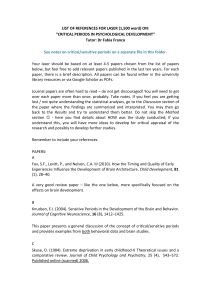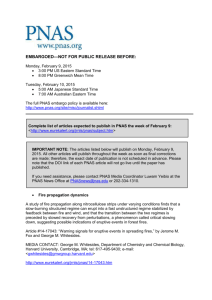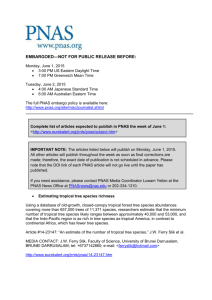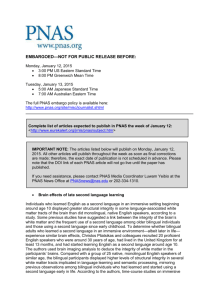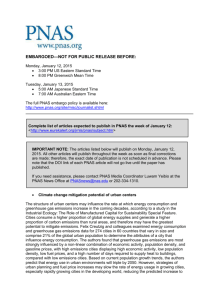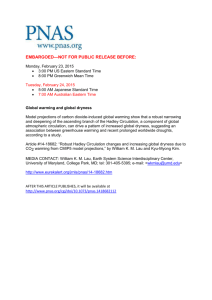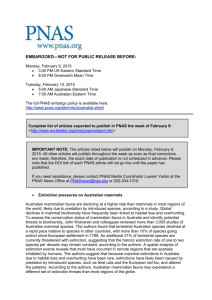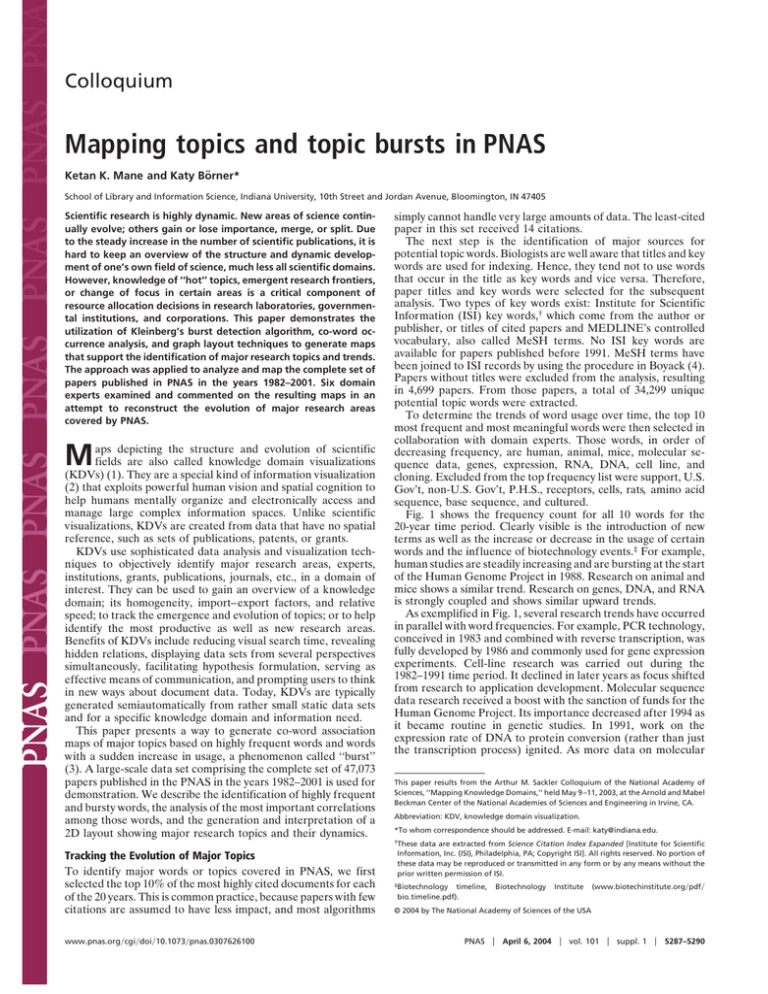
Colloquium
Mapping topics and topic bursts in PNAS
Ketan K. Mane and Katy Börner*
School of Library and Information Science, Indiana University, 10th Street and Jordan Avenue, Bloomington, IN 47405
Scientific research is highly dynamic. New areas of science continually evolve; others gain or lose importance, merge, or split. Due
to the steady increase in the number of scientific publications, it is
hard to keep an overview of the structure and dynamic development of one’s own field of science, much less all scientific domains.
However, knowledge of ‘‘hot’’ topics, emergent research frontiers,
or change of focus in certain areas is a critical component of
resource allocation decisions in research laboratories, governmental institutions, and corporations. This paper demonstrates the
utilization of Kleinberg’s burst detection algorithm, co-word occurrence analysis, and graph layout techniques to generate maps
that support the identification of major research topics and trends.
The approach was applied to analyze and map the complete set of
papers published in PNAS in the years 1982–2001. Six domain
experts examined and commented on the resulting maps in an
attempt to reconstruct the evolution of major research areas
covered by PNAS.
M
aps depicting the structure and evolution of scientific
fields are also called knowledge domain visualizations
(KDVs) (1). They are a special kind of information visualization
(2) that exploits powerful human vision and spatial cognition to
help humans mentally organize and electronically access and
manage large complex information spaces. Unlike scientific
visualizations, KDVs are created from data that have no spatial
reference, such as sets of publications, patents, or grants.
KDVs use sophisticated data analysis and visualization techniques to objectively identify major research areas, experts,
institutions, grants, publications, journals, etc., in a domain of
interest. They can be used to gain an overview of a knowledge
domain; its homogeneity, import–export factors, and relative
speed; to track the emergence and evolution of topics; or to help
identify the most productive as well as new research areas.
Benefits of KDVs include reducing visual search time, revealing
hidden relations, displaying data sets from several perspectives
simultaneously, facilitating hypothesis formulation, serving as
effective means of communication, and prompting users to think
in new ways about document data. Today, KDVs are typically
generated semiautomatically from rather small static data sets
and for a specific knowledge domain and information need.
This paper presents a way to generate co-word association
maps of major topics based on highly frequent words and words
with a sudden increase in usage, a phenomenon called ‘‘burst’’
(3). A large-scale data set comprising the complete set of 47,073
papers published in the PNAS in the years 1982–2001 is used for
demonstration. We describe the identification of highly frequent
and bursty words, the analysis of the most important correlations
among those words, and the generation and interpretation of a
2D layout showing major research topics and their dynamics.
Tracking the Evolution of Major Topics
To identify major words or topics covered in PNAS, we first
selected the top 10% of the most highly cited documents for each
of the 20 years. This is common practice, because papers with few
citations are assumed to have less impact, and most algorithms
www.pnas.org兾cgi兾doi兾10.1073兾pnas.0307626100
simply cannot handle very large amounts of data. The least-cited
paper in this set received 14 citations.
The next step is the identification of major sources for
potential topic words. Biologists are well aware that titles and key
words are used for indexing. Hence, they tend not to use words
that occur in the title as key words and vice versa. Therefore,
paper titles and key words were selected for the subsequent
analysis. Two types of key words exist: Institute for Scientific
Information (ISI) key words,† which come from the author or
publisher, or titles of cited papers and MEDLINE’s controlled
vocabulary, also called MeSH terms. No ISI key words are
available for papers published before 1991. MeSH terms have
been joined to ISI records by using the procedure in Boyack (4).
Papers without titles were excluded from the analysis, resulting
in 4,699 papers. From those papers, a total of 34,299 unique
potential topic words were extracted.
To determine the trends of word usage over time, the top 10
most frequent and most meaningful words were then selected in
collaboration with domain experts. Those words, in order of
decreasing frequency, are human, animal, mice, molecular sequence data, genes, expression, RNA, DNA, cell line, and
cloning. Excluded from the top frequency list were support, U.S.
Gov’t, non-U.S. Gov’t, P.H.S., receptors, cells, rats, amino acid
sequence, base sequence, and cultured.
Fig. 1 shows the frequency count for all 10 words for the
20-year time period. Clearly visible is the introduction of new
terms as well as the increase or decrease in the usage of certain
words and the influence of biotechnology events.‡ For example,
human studies are steadily increasing and are bursting at the start
of the Human Genome Project in 1988. Research on animal and
mice shows a similar trend. Research on genes, DNA, and RNA
is strongly coupled and shows similar upward trends.
As exemplified in Fig. 1, several research trends have occurred
in parallel with word frequencies. For example, PCR technology,
conceived in 1983 and combined with reverse transcription, was
fully developed by 1986 and commonly used for gene expression
experiments. Cell-line research was carried out during the
1982–1991 time period. It declined in later years as focus shifted
from research to application development. Molecular sequence
data research received a boost with the sanction of funds for the
Human Genome Project. Its importance decreased after 1994 as
it became routine in genetic studies. In 1991, work on the
expression rate of DNA to protein conversion (rather than just
the transcription process) ignited. As more data on molecular
This paper results from the Arthur M. Sackler Colloquium of the National Academy of
Sciences, ‘‘Mapping Knowledge Domains,’’ held May 9 –11, 2003, at the Arnold and Mabel
Beckman Center of the National Academies of Sciences and Engineering in Irvine, CA.
Abbreviation: KDV, knowledge domain visualization.
*To whom correspondence should be addressed. E-mail: katy@indiana.edu.
†These
data are extracted from Science Citation Index Expanded [Institute for Scientific
Information, Inc. (ISI), Philadelphia, PA; Copyright ISI]. All rights reserved. No portion of
these data may be reproduced or transmitted in any form or by any means without the
prior written permission of ISI.
‡Biotechnology
timeline,
bio㛭timeline.pdf).
Biotechnology
Institute
(www.biotechinstitute.org兾pdf兾
© 2004 by The National Academy of Sciences of the USA
PNAS 兩 April 6, 2004 兩 vol. 101 兩 suppl. 1 兩 5287–5290
Fig. 1.
Frequency count for the most frequently used words in the top 10% of most highly cited PNAS publications from 1982 to 2001.
sequence, expression rate, etc., became available, research toward developing molecular models and protein modeling became relevant. Cloning research had its first breakthrough result
with the successful cloning of a sheep in 1997. Molecular cloning
approaches were quickly adopted in subsequent years.
In addition to word frequency, the dynamics of topic usage
were also examined. Kleinberg’s burst detection algorithm (3)
was applied to identify topics that experience a sudden increase
in usage, also called burst. The burst detection algorithm provides a formal model for the robust and efficient identification
of word bursts. Using a finite-state automaton, bursts in streams
of words correspond to state transitions. The algorithm outputs
the start and end time of a burst as well as its strengths for each
word. Some words in the PNAS data set experience multiple
bursts. In the top 10% of the most highly cited PNAS publications, there were 1,027 unique words, of which 991 had at least
one burst, and 34 of which had two bursts. Exactly two words,
‘‘comparative study’’ and ‘‘dna primers,’’ bursted on three occasions but are not among the highly frequent words.
Mapping the Co-Occurrence Space of Topics and Topics Bursts
After analyzing the frequency occurrence of all 34,299 unique
words for each of the 20 years as well as their burstyness, we next
chose to identify and map the relationships among major topics.
Co-word occurrence analysis is a content analysis technique
that can be used to identify the strength of associations between
words based on their co-occurrence in the same document (5).
Words that appear together often will have a strength closer to
1, and words that never appear together, a strength of 0.
Although co-word spaces are typically generated based only on
highly frequent words, the work presented here is unique,
because it also accounts for word burstyness.
To begin, we computed the intersection of the highest frequency and most highly bursting word sets and selected the first
50 for further analysis. Interestingly, there was a rather low
correlation among the frequency of words and their burstyness.
In the particular example discussed here, it took 742 most
frequent words and 874 most bursty words to get an intersection
of 50 words.
5288 兩 www.pnas.org兾cgi兾doi兾10.1073兾pnas.0307626100
The co-word analysis was conducted for those 50 words and
the set of 4,699 documents. The resulting co-occurrence frequency matrix was normalized by using Salton’s cosine coefficient (6), where each word pair co-occurrence is defined as the
ratio of their co-occurrences and the product of the square root
of the respective word occurrences within the document set.
Interestingly, the original nonnormalized co-occurrence matrix
resulted in more meaningful maps, as judged by domain experts,
and will be used in the subsequent discussion.
The nonnormalized co-occurrence matrix has 1,082 nonzero
entries characterizing the complex co-occurrence relationships
among the 50 words. To reduce this number to the most
meaningful relationships, the pathfinder network scaling algorithm (PFNet) (7) was applied. The PFNet algorithm relies on
triangle inequality to eliminate unnecessary links. Given two
paths (sequence of links) in a network that connects two nodes,
the path that has a greater weight as defined via the Minkowski
metric is preserved. It is assumed that a path with a greater
weight better captures the interrelationship between two nodes,
and that alternative paths with less weight are redundant or even
counterintuitive and should be pruned from the network. Two
parameters, r and q, influence the topology of a pathfinder
network. The r parameter specifies the weight of a path based on
the Minkowski metric. The q parameter defines the number of
links in alternative paths (i.e., the length of a path) up to which
the triangle inequality must be maintained. A network of n nodes
can have a maximum path length of q ⫽ n⫺1. With q ⫽ n⫺1, the
triangle inequality is maintained throughout the entire network.
A detailed explanation of PFNet as well as another application
of it is reported in Chen (8).
Running PFNet with q ⫽ n⫺1 ⫽ 49 and infinite r results in 62
nonzero entries and hence a very sparsely connected network of
50 topic nodes and 62 edges. The many lattice-like subgraphs in
this network reveal only part of the complex relationships among
the major topics. Based on expert feedback, we selected the
network with 80 edges that was generated by using the parameter
values r ⫽ 6 and q ⫽ 49.
Subsequently, the topic word co-occurrence network was laid
out in two dimensions for visual examination. The layout deMane and Börner
Fig. 2.
Co-word space of the top 50 highly frequent and bursty words used in the top 10% most highly cited PNAS publications in 1982–2001.
picted in Fig. 2 was generated by using the Fruchterman–
Reingold 2D graph layout algorithms (9), a more efficient
version of the original spring embedding algorithm developed by
Eades (10). Each node in the network represents one of the 50
highly frequent and bursting words. Note that the words human,
animal, mice, and DNA discussed in Fig. 1 do not burst and
hence are not included in Fig. 2. The size of the node circle
corresponds to the maximum burst level this word achieved.
Color coding is used to denote the years in which the word was
used most often as well as the year of the maximum burst. Five
time durations and respective colors were used: 1982–1985,
green; 1986–1989, yellow; 1990–1993, orange; 1994–1997, red;
and 1998–2001, black. The year of the maximum frequency and
the starting year of the first burst of this word were decoded by
circle border colors and inner circle area colors, respectively. For
example, the word molecular sequence data, represented by a
circle of rather large size with an orange inner area and a red
ring, showed the highest, rather large burst between 1990 and
1993 and had a high frequency of usage in the later years
1994–1997.
Edge thickness is proportional to the number of word cooccurrences. Protein and models or cells and growth are cooccurring frequently in the selected publication data set.
The evaluation and interpretation of the resulting map are
rather difficult, because there are very few people who are
familiar with the diverse research results reported in the original
Mane and Börner
data set (4,699 highly cited PNAS papers published over a
20-year time span). However, the graph visualization shown in
Fig. 2 was examined by six biologists, and their interpretation of
the map is summarized below.
Over the last 20 years, biological research has experienced
enormous growth and also diversification. The graph shown in
Fig. 2 semantically interrelates and chronologically links diverse
fields of biological research. Four major areas can be identified
that are interlinked with the middle-oldest area of research. The
top left subnetwork is related to expression profiling and genomics research, top right topics deal with protein research, right
bottom topics are linked to cancer research, and the ones in the
left bottom relate to molecular sequence studies.
In the early 1980s, the primary research foci were structural
properties of biological entities such as cells, genes, etc. This was
followed by a phase of research in kinetics and the study of the
mutation behavior of genes. Toward the early 1990s, in conjunction with the start of the Human Genome Project, the research
paradigm shifted toward sequence data studies. During this time
period, molecular sequence data, amino acid sequences associated with the genome project, rose to prominence. Major
funding via the Human Genome Project also brought together
several interconnected research areas primarily dealing with
cloning, PCR, and gene expression depicting cloning studies.
These experiments are an extension of prior studies on plasmids,
genes, and nucleic acid hybridization. In later years, research
PNAS 兩 April 6, 2004 兩 vol. 101 兩 suppl. 1 兩 5289
concentrated on apoptosis, signal transduction, activation, and
cells linked by cell signaling pathways for programmed cell death,
a key area of cancer research. The increase in computing power
facilitated extensive research in modeling research, leading in
turn to an increased understanding about the folding patterns of
proteins. In 2000, the human genome sequence was completed,
and investigations now concentrate on protein research.
values to select a representative document and unique word set
as well as the application of pathfinder network scaling to
capture major associations among words.
The resulting visualizations were examined and interpreted by
a number of domain experts, demonstrating their readability and
practical value for the identification of topics, major trends, and
research frontiers as well as hinting at their value as a knowledge
management tool for researchers, companies, funding agencies,
and society.
Summary
Here we have demonstrated an objective computational approach to analyzing the structure and evolution of a research
domain. To our knowledge, this is the first attempt to map the
co-word space of highly frequent and bursty words. The resulting
visualization depicts 50 major topics and topic bursts in PNAS
and their evolution over a 20-year time frame.
Problems of dimensionality reduction for generating plots of
high-dimensional data sets were tackled by using threshold
We thank Anne Prieto, Don G. Gilbert, Sun Kim, Keith G. Ngolley,
Kranthi Varala, and Claire Nisonger for insightful comments on the
interpretation of the generated maps and Margaret Swan for proofreading this paper. The KNOT tools for Pathfinder Network Analysis
(http:兾兾interlinkinc.net) and PAJEK (11) were used in the presented
analysis. This work is supported by National Science Foundation
CAREER Grant IIS-0238261 and National Science Foundation Grant
DUE-0333623.
1. Börner, K., Chen, C. & Boyack, K. (2003) in Annual Review of Information
Science and Technology, ed. Cronin, B. (Information Today兾American
Society for Information Science and Technology, Medford, NJ), Vol. 37, pp.
179 –255.
2. Card, S., Mackinlay, J. & Shneiderman, B. (1999) Readings in Information
Visualization: Using Vision to Think (Morgan Kaufmann, San Francisco).
3. Kleinberg, J. M. (2002) in 8th ACM SIGKDD International Conference on
Knowledge Discovery and Data Mining (Association for Computing Machinery,
New York), pp. 91–101.
4. Boyack, K. W. (2004) Proc. Natl. Acad. Sci. USA 101, 5192–5199.
5. Callon, M., Law, J., & Rip, A. (1986) Mapping the Dynamics of
Science and Technology: Sociology of Science in the Real World (Macmillan,
London).
Salton, G. (1989) Automatic Text Processing: The Transformation, Analysis, and
Retrieval of Information by Computer (Addison–Wesley, New York).
Schvaneveldt, R. W. (1990) Pathfinder Associative Networks: Studies in Knowledge Organization. (Ablex, Norwood, NJ).
Chen, C. (2004) Proc. Natl. Acad. Sci. USA 101, 5303–5310.
Fruchterman, T. M. J. & Reingold, E. M. (1991) Software Pract. Exp. 21,
1129–1164.
Eades, P. (1984) Cong. Numer. 42, 149–160.
Batagelj, V. & Mrvar, A. (1998) PAJEK–A Program for Large Network Analysis
Connections 21, 47–57.
5290 兩 www.pnas.org兾cgi兾doi兾10.1073兾pnas.0307626100
6.
7.
8.
9.
10.
11.
Mane and Börner

